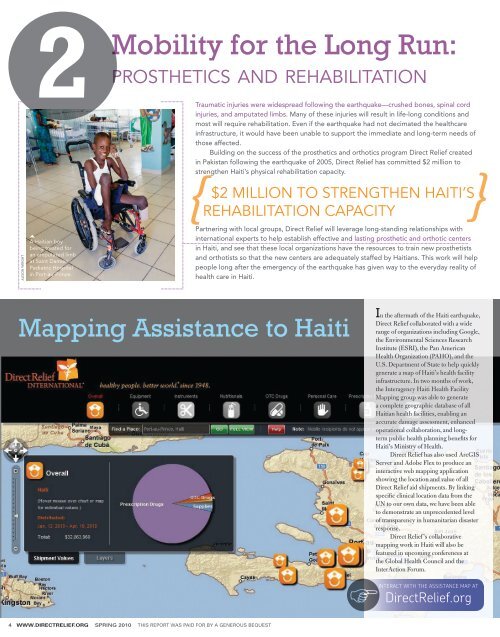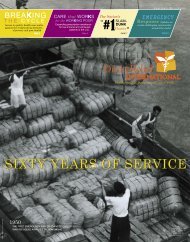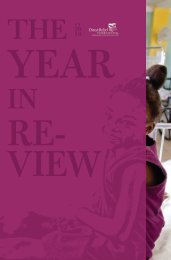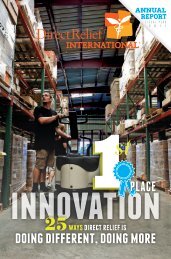2010 Spring Newsletter - Direct Relief
2010 Spring Newsletter - Direct Relief
2010 Spring Newsletter - Direct Relief
Create successful ePaper yourself
Turn your PDF publications into a flip-book with our unique Google optimized e-Paper software.
Mobility for the Long Run:<br />
prosthetics and rehabilitation<br />
ALISON WRIGHT<br />
A Haitian boy<br />
being treated for<br />
an amputated limb<br />
at Saint Damien<br />
Pediatric Hospital<br />
in Port-au-Prince.<br />
Traumatic injuries were widespread following the earthquake—crushed bones, spinal cord<br />
injuries, and amputated limbs. Many of these injuries will result in life-long conditions and<br />
most will require rehabilitation. Even if the earthquake had not decimated the healthcare<br />
infrastructure, it would have been unable to support the immediate and long-term needs of<br />
those affected.<br />
Building on the success of the prosthetics and orthotics program <strong>Direct</strong> <strong>Relief</strong> created<br />
in Pakistan following the earthquake of 2005, <strong>Direct</strong> <strong>Relief</strong> has committed $2 million to<br />
strengthen Haiti’s physical rehabilitation capacity.<br />
$2 MILLION TO STRENGTHEN HAITI’S<br />
REHABILITATION CAPACITY<br />
Partnering with local groups, <strong>Direct</strong> <strong>Relief</strong> will leverage long-standing relationships with<br />
international experts to help establish effective and lasting prosthetic and orthotic centers<br />
in Haiti, and see that these local organizations have the resources to train new prosthetists<br />
and orthotists so that the new centers are adequately staffed by Haitians. This work will help<br />
people long after the emergency of the earthquake has given way to the everyday reality of<br />
health care in Haiti.<br />
Mapping Assistance to Haiti<br />
In the aftermath of the Haiti earthquake,<br />
<strong>Direct</strong> <strong>Relief</strong> collaborated with a wide<br />
range of organizations including Google,<br />
the Environmental Sciences Research<br />
Institute (ESRI), the Pan American<br />
Health Organization (PAHO), and the<br />
U.S. Department of State to help quickly<br />
generate a map of Haiti’s health facility<br />
infrastructure. In two months of work,<br />
the Interagency Haiti Health Facility<br />
Mapping group was able to generate<br />
a complete geographic database of all<br />
Haitian health facilities, enabling an<br />
accurate damage assessment, enhanced<br />
operational collaboration, and longterm<br />
public health planning benefits for<br />
Haiti’s Ministry of Health.<br />
<strong>Direct</strong> <strong>Relief</strong> has also used ArcGIS<br />
Server and Adobe Flex to produce an<br />
interactive web mapping application<br />
showing the location and value of all<br />
<strong>Direct</strong> <strong>Relief</strong> aid shipments. By linking<br />
specific clinical location data from the<br />
UN to our own data, we have been able<br />
to demonstrate an unprecedented level<br />
of transparency in humanitarian disaster<br />
response.<br />
<strong>Direct</strong> <strong>Relief</strong> ’s collaborative<br />
mapping work in Haiti will also be<br />
featured in upcoming conferences at<br />
the Global Health Council and the<br />
InterAction Forum.<br />
INTERACT WITH THE ASSISTANCE MAP AT<br />
<strong>Direct</strong><strong>Relief</strong>.org<br />
4 WWW.DIRECTRELIEF.ORG SPRING <strong>2010</strong> THIS REPORT WAS PAID FOR BY A GENEROUS BEQUEST








